3 Simple Poses to Ease Neck Pain
Do you have neck pain? Can you feel it when you flex, extend, or rotate? Maybe you had an accident and you have whiplash, or, like me, you suddenly experienced pain and you’re not really sure why.
Of all the aches and pains you can experience in your body, neck pain can feel sudden and scary, and you may find it difficult to know what to do about it.
I once tweaked the C7 nerve in my neck doing yoga. I wasn’t doing anything extreme or unusual, but for whatever reason the nerve pinched, and the pain was so intense around my right scapula, I collapsed onto my mat. It was such a strange pain and felt as though my triceps had given up on me. At that point I didn’t even realise the pain was connected to my cervical spine.
The good news is that my pain diminished very quickly and the exercises I’ll share with you in a moment helped to speed up the process. Hopefully they will also help to accelerate your own healing journey.
Anatomy of the Neck
First, let’s take a look at the inner workings of this complex area of the body.
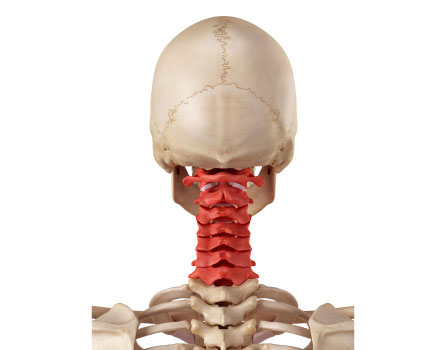 |
Cervical Spine Your cervical spine contains the thinnest and smallest bones in the spinal column, your cervical vertebrae 1-7. These bones have a huge range of motion mostly thanks to the axis and atlas vertebrae C1 and C2 up at the top. Their unique shape and function enable your neck to turn, twist, look up, and bend down. However, this range of motion also means that the cervical spine’s corresponding intervertebral discs, nerve roots, muscles, tendons, and ligaments can become injured or inflamed. |
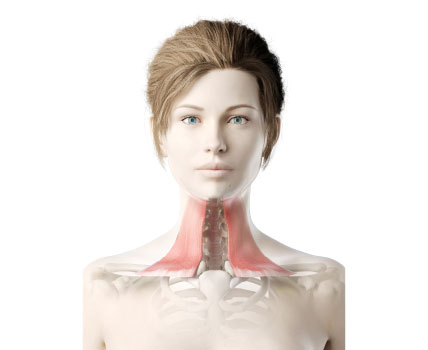 |
Platysma Muscle This thin, superficial, sheet-like muscle sits at the front of your neck from your collarbone to your jaw. It’s involved in facial movements and expressions. It can be strained due to overuse or damaged during trauma or whiplash. |
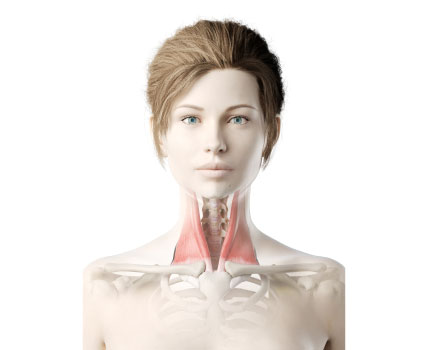 |
Sternocleidomastoid This large, mostly superficial muscle is responsible for helping you to flex your neck and extend your head. It extends from your collarbone to behind your ears. Irregular movements of your head or neck, such as during an accident or a fall, or when doing overhead activities, can affect this muscle. |
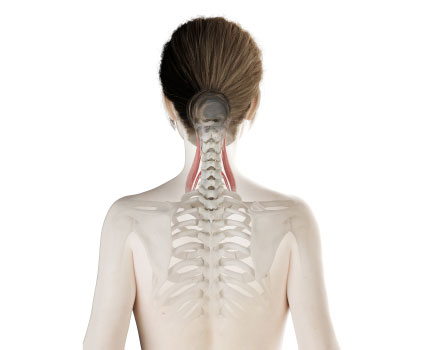 |
Scalene Muscles These three muscles – anterior, middle (pictured) and posterior scalene run down either side of the neck, from your cervical spine to the top of your ribcage. They are responsible for rotation and lateral flexion of the neck and also serve as accessory muscles for breathing as they help to elevate the ribs. They are commonly damaged during whiplash. |
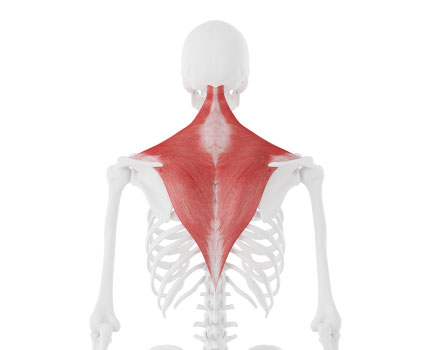 |
Trapezius This large, flat muscle starts at the base of your neck and extends to the middle of your back. It’s divided into three areas–upper, middle and lower–and is mostly responsible for your shoulder movements. The upper trapezius helps your neck and head to extend and tilt and your shoulders to rotate and elevate. Injuries here are commonly caused by overuse or aggressive twists such as during an accident. |
Common Causes of neck Pain
The most common causes of neck pain include poor posture while working or sleeping, poor alignment while exercising (especially during overhead press movements), car accidents, slips and falls, and general aging. The resulting injuries normally tend to fall into one of the following categories:
Muscle Injuries
There are more than 20 muscles from the base of your skull to your collarbone and shoulders. Just like all muscles, you can overuse, overstretch, and even strain the muscles in your neck, and they can be extremely painful. Although the vertebrae in the cervical spine are small, that does not mean that this area is weak. If you have a strong spine, it means the muscles that surround and support the spine are strong.
Disc Injuries
Just like in the lumbar spine, disc injuries are very common. They usually occur in the C5, C6, C7 regions, and usually involve a posterior bulge or herniation that may or may not include impingement on a nerve. When you have disc damage in your cervical spine, don’t think of it as a lifelong sentence of pain. You can often overcome this in a matter of weeks or months, without surgery or medical intervention.
Degenerative Injuries
As you get older, your body starts to break down. Conditions such as cervical spondylosis or osteoarthritis (the degradation of intervertebral discs) are common with age and overuse. Other common problems include stenosis, the narrowing of the foramen (holes) where your spinal cord or nerve roots, bone spurs, and facet joint syndrome.
It’s important to gather as much information about the condition causing your neck pain as possible, but whatever the trigger, the path toward healing is often very similar and tends to focus on a combination of strength and flexibility practices. Most neck pain issues will resolve within four to eight weeks.
3 Of the Best Neck Exercises
These three corrective exercises each focus on a different goal – strengthening the muscles supporting the cervical spine, increasing flexibility for better mobility in your neck, and finally using traction, which can be extremely helpful in relieving impingement.
These exercises assume that your injury is recent and intense. As a result, they are very mild and gentle by design, you will eventually scale these up and increase the intensity once you start to heal. But for now, please be gentle and as always, check with your doctor before starting any self-care routine.
Isometric Neck Press
Isometric stretches like this one are good for strengthening your neck muscles.
- Take your right hand and press your fingers into the side of your head (image 1). Using the muscles of your neck, brace against the push with a five out of 10 intensity. Hold for 30 seconds, then switch sides.
- Next, place your hands in front of your forehead (image 2) interlace your fingers and use the muscles in your neck to press your forehead into your hands. Hold for 30 seconds with a five out of 10 intensity.
- Finally, place your hands at the back of your head in a sit-up style (image 3). Interlace your fingers and use your neck muscles to gently press your head against your hands. Hold for 30 seconds with a five out of 10 intensity. Release your hands and shake it out.
- You can do this isometric pose multiple times throughout the day. Be sure to start out gently and stick to 30-second holds on each of the four sides. If you feel any pain at all reduce the intensity.
Neck Roll
This pose will help to mobilize and increase the flexibility in the muscles that support the cervical spine.
- Start by flexing your neck, dropping your chin towards your chest. Then slowly and steadily elevate (shrug) your shoulders, depress (unshrug) your shoulders, protract your shoulders (spread your shoulder blades apart), and finally retract them (squeeze your shoulder blades together). Return to centre and release.
- Next take your tongue and press it into the roof of your mouth. Drop your head back as far as you feel comfortable. Pause, then as previous, slowly elevate, depress, protract, and retract your shoulders. Return to centre and release.
- Next tilt your head moving your right ear towards your right shoulder (image 1). Pause, then as previous, slowly elevate, depress, protract, and retract your shoulders. Return to centre, release, and switch sides.
- Next tilt your head to the right, looking at your right foot (image 2). Pause, then as previous, slowly elevate, depress, protract, and retract your shoulders. Return to centre, release, and switch sides.
- Finally, turn your chin to look up to the right (image 3). Pause, then as previous, slowly elevate, depress, protract, and retract your shoulders. Return to centre, release, and switch sides.
Supported Shoulder Stand
Traction poses like this one help to slightly increase the space between the intervertebral discs, which for many people offers immediate relief from impingement pain. It can look quite intimidating, but almost everyone can do this pose, even if you’ve never gone upside down before.
- Place two chairs or stools together, on a carpet or sticky mat, next to a wall. Add flat cushions on top and leave a slight distance between the stools – enough to fit your head and neck in the space comfortably.
- Place your shoulders on the stool and lift your hips up to the wall (use a spotter to help raise your legs, if possible).
- Relax your head and neck and allow the crown of your head to move down towards the floor.
- Breathe through your nose and hold for 20 seconds.
- As you get more comfortable, work up to a 1–2 minute hold.
- After you come down it’s normal to feel a little heat in your head, so relax in child’s pose on the floor for a few seconds, before slowly making your way back up to standing.
Neck Exercises & Pain
If you’re experiencing dizziness, bladder problems, muscle weakness in your shoulder, arm, or hand, see a doctor. If you have radiating pain, I’d encourage you to see a specialist. Based on some very simple tests, it’s often possible for doctors to identify which nerve or nerves are affected, and the more you know about your injury, the easier it is to heal.
Want to Learn More?
- Science of Stretching 5-Day Program
- Lucas’s YouTube Channel (free to subscribe)
-
- The Lucas Rockwood Show Podcast
 Article by
Article by 



